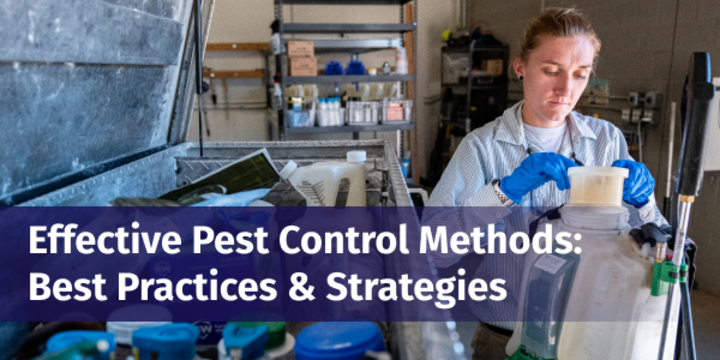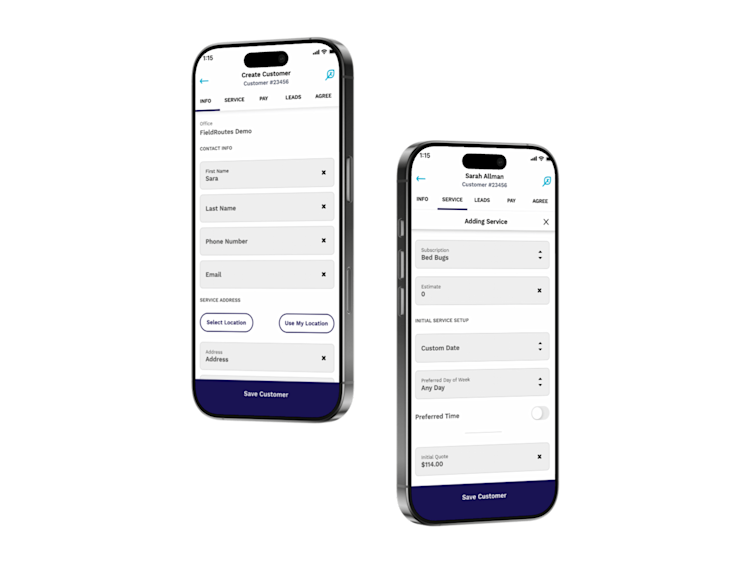Effective Pest Control Methods: Best Practices & Strategies

Pest control methods fall into four main categories: physical pest control, chemical pest control, biological pest control, and integrated pest management (IPM), which blends all three for a holistic approach.
For example, releasing ladybugs, applying neem oil, and planting marigolds form part of an IPM program. Staying current with these pest control methods enables your business to effectively tackle any infestation and deliver tailored, effective pest control services to every customer.
Physical Pest Control
Physical pest control methods are among the oldest and most practical ways to manage pest problems. These approaches include barriers, traps, and mechanical tools designed to block, capture, or remove pests without heavy reliance on chemical pesticides. From sealing cracks to vacuuming for insects, these methods are effective in tackling common pests such as cockroaches, termites, and bed bugs.
Barriers and exclusion methods
Barriers and exclusion methods create a physical or chemical boundary that pests can’t cross. For example, a window screen prevents flies and wasps from entering while allowing ventilation. Similarly, installing door sweeps or sealing gaps deters rodents and cockroaches.
The pros
Effective for preventing pests before an infestation starts.
Eco-friendly since they reduce the need for chemical pest control measures.
Long-lasting solutions that improve overall building maintenance.
The cons
Routine inspection and maintenance are required to remain effective.
It may be less effective against flying insect pests, such as mosquitoes, without additional pest control services.
Installation costs for high-quality materials can be higher upfront.
The average costs
The cost of installing basic barriers (such as door sweeps or window screens) for a 3-bedroom home typically ranges from $100–$300, depending on materials and labor. More advanced exclusion systems, such as foundation sealing, may incur higher costs based on square footage and the severity of entry points.
Traps and capture devices
Traps are versatile and widely used to catch rodents, mites, or crawling insects. Examples include glue boards, bait stations, and slug traps using beer dishes. These devices work best when placed along the paths that pests travel.
The pros
Provide a targeted approach to kill pests or capture them alive for identification.
Easy to set up and maintain, requiring minimal training.
Cost-effective compared to large-scale chemical pest control.
The cons
Must be monitored and reset frequently.
It may not be effective for larger pest populations or infestations.
It can create sanitation concerns if not checked regularly.
The average costs
Basic traps, such as glue boards, cost as little as $5–$10 each. Larger refillable bait stations or multi-catch traps for rodents typically range from $25 to $50 per device.
Mechanical removal techniques
Mechanical techniques involve physically removing pests—such as picking caterpillars and larvae off plants or tilling soil to expose grubs. These methods appeal to eco-conscious customers as they avoid the use of chemical pesticides.
The pros
Safe for beneficial insects and pollinators, such as bees and ladybugs.
Low environmental impact compared to chemical pest control.
Effective for small-scale pest problems, such as aphids or mites on plants.
The cons
Time-consuming and labor-intensive, especially for larger infestations.
Results depend heavily on technician skill and persistence.
Not scalable for large agricultural or commercial properties.
The average costs
Mechanical pest control is typically billed by the hour. For residential services, prices range from $75 to $150 per visit, depending on the property size and the severity of the pest problem.
Vacuuming and suction methods
Vacuuming is an effective way to reduce insect pests, particularly bed bugs, fleas, and cockroaches. Suction tools can also collect droppings or larvae for identification while minimizing the release of allergens.
The pros
Removes pests immediately, without waiting for baits or pesticides to take effect.
Ideal for hard-to-reach areas, such as cracks and crevices.
Reduces the need for chemical pesticides, lowering toxicity risks.
The cons
Works best as part of an integrated pest management (IPM) plan rather than as a standalone method.
Requires professional HEPA vacuums, which are more expensive.
It can be less effective for outdoor pest populations.
The average costs
A vacuuming treatment for a 3-bedroom home, such as for bed bug removal, can cost between $150 and $300, depending on the infestation level and the number of follow-up visits.
Physical pest control measures form the foundation of many pest control services and pair well with other strategies, including integrated pest management, for long-term effectiveness.
Biological Pest Control
Biological pest control leverages natural predators, parasites, and microorganisms to manage pest populations. These eco-friendly methods range from releasing ladybugs to control aphids to applying nematodes that attack soil-dwelling larvae. For pest control services focused on reducing chemical pesticides and supporting a healthy ecosystem, biological pest control is a core strategy.
Predatory insects and invertebrates
Predatory insects and invertebrates use the natural predator-prey relationship to control insect pests. Common examples include ladybugs, green lacewing larvae, and predatory mites that target spider mites and aphids.
The pros
Effective against specific types of pests, such as aphids, thrips, and mites.
Safe for beneficial insects when applied correctly, making it ideal for integrated pest management (IPM).
Low toxicity, with no harmful chemical residues affecting plants or soil.
The cons
Limited effectiveness indoors or in highly controlled environments, such as greenhouses, without proper conditions.
Some predatory insects may consume beneficial insects if populations overlap.
Customers may be wary of introducing more insects into their environment.
The average costs
A typical release of predatory insects for a 3-bedroom home garden or greenhouse can cost between $50 and $150, depending on the species and the volume required.
Parasitoids and parasitic nematodes
Parasitoids, such as certain wasps and flies, attack pest larvae or eggs, while parasitic nematodes, like Steinernema carpocapsae, target soil-dwelling pests, including grubs, fleas, and caterpillars. These living organisms infiltrate pests and release bacteria to kill them.
The pros
Highly targeted pest control with minimal impact on non-target organisms.
It can be applied efficiently over large areas, particularly in lawns or agricultural settings.
Safe for humans, pets, and plants when applied correctly.
The cons
Nematodes and parasitoids require specific conditions (moist soil, low sunlight) to survive and work effectively.
Short shelf life; they must be used soon after purchase.
Slower results compared to chemical pesticides, sometimes requiring multiple treatments.
The average costs
Applying parasitic nematodes for a 3-bedroom home's lawn or garden typically ranges from $75 to $200, depending on the coverage area and pest infestation levels.
Biological pest control offers a sustainable way to manage pest populations, particularly when combined with other pest control methods in an IPM approach.
Microbial Control Agents
Microbial pest control employs microorganisms and pathogens—such as bacteria, fungi, and viruses—to naturally suppress insect pests. These living organisms are formulated into biological pesticides and applied to target pest populations. When insects ingest or come into contact with these microbial agents, they are infected and eventually killed, reducing the need for chemical pesticides.
Bacillus thuringiensis (Bt) is one of the most widely used microbial control agents. Found in more than 130 pesticide products, Bt is effective against specific insect pests like caterpillars, beetles, and mosquito larvae. By targeting only particular species, Bt helps protect beneficial insects and reduces harm to the surrounding ecosystem.
Microbial pest control methods are eco-friendly and often recommended for integrated pest management (IPM) programs. According to the EPA, microbial pesticides are generally low in toxicity to humans and animals and can be effective in small doses. They are commonly used in greenhouses, crop protection, and residential gardens where natural pest control is preferred.
However, microbial agents have limitations. Their shelf life is shorter compared to chemical pesticides, and their narrow host range means you may need several products to tackle different types of pests. Environmental factors, such as sunlight, humidity, and soil conditions, also affect their performance.
Microbial control agents are an excellent choice for pest control services looking to combine effectiveness with environmental responsibility, especially when paired with other methods in an IPM program.
Chemical Pest Control
Chemical pesticides remain among the most effective tools for managing pest infestations, from insect pests to invasive weeds; however, their power demands responsible use. Modern pest management often combines chemical pest control with other methods, such as integrated pest management (IPM), to minimize risks while achieving effective results.
Using chemical pesticides wisely helps minimise toxicity and protect both customers and the surrounding ecosystem.
When considering a chemical pesticide, always review the label, confirm you can safely handle it, and ensure it fits seamlessly into your service routine. Proper application techniques and adherence to Environmental Protection Agency (EPA) standards protect both people and pets while ensuring reliable outcomes.
Types of chemical pest control methods
Chemical pesticides generally fall into three primary categories:
Insecticides
Insecticides target various insect pests, including cockroaches, fleas, bed bugs, termites, and caterpillars. Some act instantly, while others, like insect growth regulators (IGRs), disrupt the insect’s life cycle. Bacillus thuringiensis (Bt) is an example of a microbial-based insecticide that’s commonly used in eco-friendly pest control.Rodenticides
These chemical pesticides are formulated to kill rodents like mice and rats. Due to their high toxicity, rodenticides require careful application and storage to prevent harm to pets and wildlife.Herbicides
Herbicides kill unwanted plants or weeds, which are considered pests in agricultural or residential settings. Many lawn care professionals integrate herbicides with pest control services to create landscapes that are resistant to pests.
With the insecticide market projected to reach $22 billion by 2030, chemical pest control methods remain a central part of modern pest control services.
Factors when selecting chemical pest control methods
Before choosing any chemical pest control solution, consider the following:
Safety precautions
Ensure you have the necessary personal protective equipment (PPE), safe storage options, and proper ventilation. Handling chemical pesticides safely reduces the risk of accidental exposure.Environmental impact
Consider how you’ll store unused chemicals and dispose of containers to prevent contamination of water or soil. Responsible use of chemical pest control supports a healthier ecosystem.Regulatory compliance
Pesticide use must align with both state and federal regulations. The National Pesticide Information Center (NPIC) provides state-specific resources and regulatory guidance.
Pros of chemical pest control
Fast-acting solutions for severe infestations.
Effective across a wide range of pest types, from termites to wasps.
Compatible with other methods, such as cultural control and trap cropping.
Cons of chemical pest control
Risk of toxicity to humans, pets, and beneficial insects like pollinators.
Overuse may lead to pesticide resistance in pest populations.
Requires strict safety measures, disposal procedures, and ongoing training.
Average costs
For a standard 3-bedroom home, professional chemical treatments typically cost:
$100–$300 for insecticide spraying (fleas, cockroaches, or ants).
$150–$350 for rodenticide treatments (includes baiting and monitoring).
$80–$200 for herbicide applications in lawns or gardens. The cost varies depending on the severity, frequency of application, and type of service.
Chemical pest control is most effective when combined with other pest control measures as part of a broader strategy like IPM.
Integrated Pest Management (IPM)
Integrated pest management (IPM) focuses on sustainable, long-term pest control by combining multiple techniques into a customized strategy. This holistic approach prioritizes environmental safety while delivering effective pest management results. Its main objectives include:
Reducing reliance on chemical pesticides by using biological and cultural control methods.
Maintaining balance within the ecosystem to protect beneficial insects and microorganisms.
Addressing pest problems with a plan tailored to the specific environment and type of pest infestation.
Customers appreciate IPM because it uses minimal chemical pesticides while maintaining effective control measures. For example, the Oklahoma State University greenhouse IPM program prioritizes biological solutions such as horticultural oils, insect growth regulators, and botanicals to reduce toxicity and protect pollinators.
IPM core practices
IPM is not a one-time treatment but an ongoing process of monitoring, prevention, and targeted intervention. By combining physical pest control, biological pest control, and cultural practices, it builds pest-resistant environments that minimize risk.
Pest identification
Accurate pest identification ensures you only treat actual pest problems. For example, distinguishing between beneficial insects, such as ladybugs, and destructive pests, like aphids, prevents unnecessary pesticide use.Scouting and monitoring
Regular inspections—daily or weekly—help track pest populations and life cycle stages. This includes checking under leaves, along walls, and at bait stations for early signs of infestation.Prevention
Proactively address pest risks by removing standing water to deter mosquitoes and sealing entry points to prevent cockroaches and termites from gaining access.Threshold-based decision-making
Action is taken only when pest activity reaches a defined threshold. A few wasps in a garden may be acceptable, but growing numbers indicate the need for nest removal.Implementation of control methods
IPM combines techniques such as trap cropping, physical barriers, and the limited use of insecticides to achieve maximum effectiveness with minimal environmental impact. For example, planting zinnia as a trap crop for Japanese beetles can reduce the need for widespread chemical treatments.
IPM offers pest control services with a structured approach to deliver safe, effective, and environmentally responsible solutions while building long-term customer trust.
What Factors Determine the Choice of Pest Control Method?
No single pest control method works for every situation. Each pest problem requires a tailored approach that considers the environment, the type of infestation, and the long-term effectiveness of the chosen strategy. Pest control professionals evaluate multiple factors before deciding which combination of physical, biological, chemical, or integrated pest management (IPM) techniques to apply.
One of the most critical considerations is the type of pest.
Insect pests such as termites, cockroaches, and fleas require different solutions than rodents or mites. For instance, bed bugs may be best managed through a combination of heat treatments and chemical pesticides. At the same time, aphids can often be controlled with the help of beneficial insects, such as ladybugs.
The severity and scale of infestation also play a significant role. A small, localized pest problem can often be resolved with cultural control measures, such as sealing cracks or using traps. Larger infestations, particularly in commercial or agricultural settings, frequently require a more comprehensive approach that combines chemical pest control with ongoing monitoring.
Location is another deciding factor. Pest control methods for residential homes differ from those used in restaurants, greenhouses, or food-processing facilities due to health, sanitation, and industry-specific regulations.
Professionals also assess health and safety concerns to ensure treatments are safe for people, pets, and property. Budget and resources also influence the decision, as some methods, such as fumigation or biological pest control, may require specialized equipment or recurring applications.
Through diagnostic inspections and tailored planning, pest control services often combine methods for greater effectiveness while complying with industry best practices.
Selecting the correct pest control method ensures both immediate results and sustainable long-term management.
What Environmental Impacts Can Result From Different Pest Control Methods?
Pest control strategies, when misapplied, can have significant environmental consequences. While these methods are essential for controlling pest infestations and protecting property, their improper use may harm ecosystems and non-target species. Professionals must strike a balance between effectiveness and sustainability to minimize their environmental footprint.
Chemical pesticides can contaminate soil, water, and air if overused or misapplied. They may harm pollinators, such as bees, as well as aquatic life and beneficial insects. Repeated exposure to chemical pesticides can also lead to pesticide resistance, making pests harder to control over time.
Biological methods are generally eco-friendly but can disrupt ecosystems if non-native predators, parasitoids, or microorganisms are introduced without proper oversight.
Mechanical or physical pest control has a lower environmental impact but can still disturb habitats and local biodiversity if used excessively, especially in sensitive outdoor ecosystems.
To mitigate these effects, pest control services are increasingly adopting eco-certified products, targeted treatments, and IPM approaches. Regulatory agencies such as the EPA and local environmental boards provide guidelines for safe and sustainable pest management practices.
How effective are natural or organic pest control alternatives?
Natural and organic pest control methods use substances or organisms derived from nature, such as essential oils, diatomaceous earth, neem oil, botanical insecticides, and beneficial insects like ladybugs or nematodes. These alternatives are valued for their lower toxicity, reduced environmental risks, and growing consumer preference—particularly in homes, schools, and organic farming operations.
However, these products often have shorter residual effects and act more slowly compared to chemical pesticides. They may not be sufficient for severe infestations of cockroaches, termites, or bed bugs. For example, diatomaceous earth is effective against fleas and ants, but it requires repeated applications to maintain its effectiveness.
Organic pest control is best suited for mild infestations, sensitive environments, or as part of a broader IPM strategy that combines multiple approaches. As market demand increases, new formulations of natural pesticides are emerging; however, pest control professionals must still evaluate the efficacy of each product before use.
Environmentally responsible practices—such as combining natural treatments with mechanical or biological methods—can significantly reduce long-term environmental impact while maintaining effective pest control.
Level Up Your Pest Control Business
Staying current with the latest pest control methods—whether physical, biological, microbial, or chemical—gives you a competitive edge and ensures you deliver the most effective solutions to your customers. By understanding the environmental impacts, selecting methods based on detailed inspections, and adopting integrated pest management (IPM) strategies, you position your business for long-term success.
Focus on prevention. Preventing a pest infestation is always easier and more cost-effective than eliminating one. Recommend proactive measures such as sealing cracks, improving sanitation, or removing standing water.
Identify and tailor treatments. Proper pest identification and an assessment of the environment allow you to choose the right solution—whether that’s cultural control, biological pest control, or targeted chemical treatments.
Stay persistent. Pest control is not a one-time fix but an ongoing process. Documenting progress with photos and customer notes can build trust and showcase results over time.
The complexity of choosing the proper pest control measures is only part of the challenge. Running a pest control business also requires efficient scheduling, customer communication, and accurate reporting. FieldRoutes, a ServiceTitan company, streamlines this process with software designed to automate operations and enhance efficiency.
Schedule a free demo to see how FieldRoutes® can help you deliver better service, streamline tasks, and grow your pest control business.
Frequently Asked Questions (FAQs)
What are the long-term effects of using pesticides?
Prolonged or excessive use of chemical pesticides can lead to soil and water contamination, harm beneficial insects like pollinators, and create pesticide-resistant pest populations. This is why many pest control services combine IPM strategies with targeted pesticide use to minimize environmental and health risks.
How long do pest control methods remain effective?
The effectiveness of pest control methods depends on the type of treatment, pest species, and environment. Chemical treatments may last several weeks, while biological pest control or cultural control methods often require ongoing monitoring. Integrated approaches, such as IPM, extend their results by combining multiple strategies for long-term prevention.
What are common household pest control techniques?
Household pest control methods include sealing entry points, using traps or bait stations, applying insecticides, and introducing natural remedies such as diatomaceous earth. Homeowners may also utilize professional pest control services for persistent issues, such as bed bugs or termites, to ensure thorough and lasting treatment.





![10 Pest Control Tools Every Technician & Company Needs [2025]](https://images.ctfassets.net/7i0yc949tatx/7cqTUOBQEUPSU4570lOSRf/be27fcb0297c1dd6fcab89b0a53094a7/FRT-Blog-Best-Pest-Tools-0623-PL.jpg?w=720&h=360&fl=progressive&q=100&fm=jpg)